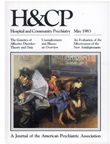Schizophrenia: A Review of Diagnostic and Biological Issues II. Biological Issues
Abstract
Over the years schizophrenia has been the object of an extensive amount of research. In Part I of this paper, published in the April H& CP, the authors discussed research into diagnosis and prognosis. In particular, they outlined the studies that have been done on the major diagnostic systems, induding the first-rank symptoms, theflexible system, the New Haven Schizophrenia Index, the Feigbner criteria, the Research Diagnostic Criteria, and the Diagnostic and Statistical Manual of Mental Disorders, third edition. in Part ii they describe the literature on biological issues in schizophrenia. included in their survey are the studies on neuropathological Issues and on genetic and biological hypotheses of etiology and pathogenesis. in particular they discuss the possible roles ofdopamine, endorphins and neuropeptides, endogenous psychotomimetics, and viruses in schizophrenia.
Access content
To read the fulltext, please use one of the options below to sign in or purchase access.- Personal login
- Institutional Login
- Sign in via OpenAthens
- Register for access
-
Please login/register if you wish to pair your device and check access availability.
Not a subscriber?
PsychiatryOnline subscription options offer access to the DSM-5 library, books, journals, CME, and patient resources. This all-in-one virtual library provides psychiatrists and mental health professionals with key resources for diagnosis, treatment, research, and professional development.
Need more help? PsychiatryOnline Customer Service may be reached by emailing [email protected] or by calling 800-368-5777 (in the U.S.) or 703-907-7322 (outside the U.S.).



